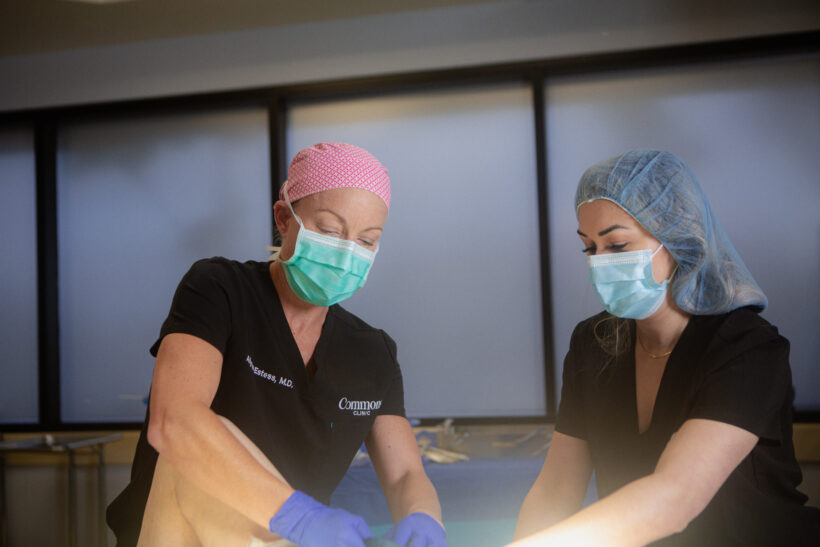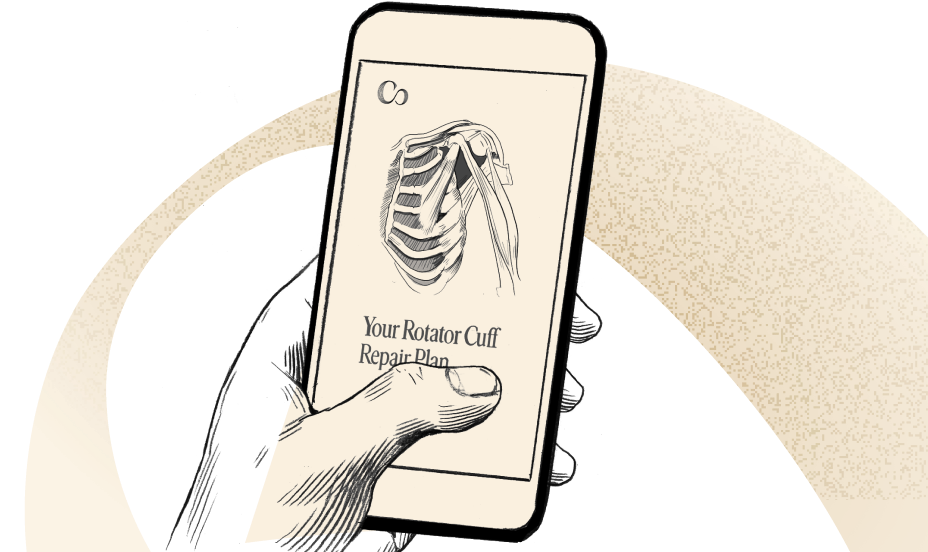Hip Arthroscopy 101 — Procedure and Recovery Guide
Experiencing hip pain and wondering if hip arthroscopy can help? Here’s everything you need to know about this procedure.
If your hip flares up in pain when you do squats at the gym, or if you feel pain deep in your hip during certain movements, consider scheduling a hip arthroscopy. This minimally invasive surgery may be a good option to relieve hip pain and prevent future complications. Although hip arthroscopy is not the first line of defense, it may be something that’s recommended by an orthopedic surgeon when physical therapy, lifestyle adjustments, or pain medications aren’t working.
Hip arthroscopy takes about two to three hours to complete, and many patients are able to walk immediately after surgery with the assistance of crutches. Ahead, we’ll go into more detail about what hip arthroscopy is, when it’s a good option, and what the recovery process looks like.
What is Hip Arthroscopy?

“Hip arthroscopy is a minimally invasive surgery that allows for direct treatment of hip issues such as a labral tear, femoroacetabular impingement (FAI), and other conditions,” says Moin Salah, MD, MBA, medical director of clinical operations at Commons Clinic. Since the procedure is minimally invasive, it’s potentially a lower-risk way to reduce hip pain, allowing patients to enjoy a more active, pain-free lifestyle. It’s typically recommended when conservative treatment has failed.
This surgery is done by an experienced orthopedic surgeon who will make small cuts around the hip. Once inside, the surgeon may repair torn cartilage and reshape the hip joint to remove abnormal bone that contributes to impingement. Surgeons may also repair a torn labrum, a cartilage ring that helps stabilize the hip, and shave down extra bumps of bone around the ball and socket parts of the joint.
Hip arthroscopy occurs in the hip joint, which is made up of the hip ball, hip socket, and cartilage. The ball and socket are part of the pelvis and the femur, providing stability to the region. Between the ball and socket is a layer of articular cartilage, a smooth white coating that allows the ball and socket to glide across each other. This gliding occurs whenever you move your hip, whether to stretch, walk up stairs, or do other physical movements with your legs. If there’s something wrong with the cartilage, ball, or socket, the ball may no longer glide smoothly in the socket, and torn pieces of cartilage may catch or lock, sending pain throughout this region.
Who is a Candidate for Hip Arthroscopy?
“An ideal candidate for hip arthroscopy is often someone who has been dealing with persistent hip pain that hasn’t improved with more conservative treatments, like rest, physical therapy, or pain medications,” says Taher Saifullah, MD, founder of Spine & Pain Institute Los Angeles.
Someone should ideally be in their late teens or 20s when getting this surgery, though some older individuals who are physically active may also be strong candidates. A runner in their 20s who is held back from enjoying an active lifestyle due to hip pain may be a good candidate. At the same time, an equally active person in their 40s who isn’t seeing results from physical therapy may also be a good candidate. A surgeon or doctor will make the call on if you’re a good candidate, based on history, exam, and imaging study findings.
The surgery’s chance of success goes beyond age and fitness level. There should also not be advanced arthritis in the hip, says Tigran Garabekyan, MD, orthopedic surgeon at Commons Clinic. If someone has more advanced arthritis in the hip, the surgery won’t result in long-lasting pain relief since it can’t treat arthritis in the more advanced stages. That said, the procedure can be a preventative measure to ensure arthritis doesn’t escalate to a more severe phase because the surgery may repair parts of the hip impacted by arthritis pain.
If a surgeon or doctor determines you’re not a good candidate for this procedure, they may recommend another hip surgery or an alternative treatment, like physical therapy or medication. The most common alternative surgery is a hip replacement.
Conditions Treated with Hip Arthroscopy

Hip arthroscopy is a “joint preserving” procedure that can address hip joint problems without needing to replace the joint. Dr. Garabekyan explains, “Hip arthroscopy is commonly used to address pre-arthritic hip conditions, such as hip impingement and instability. These issues can arise in younger individuals but often become symptomatic only after significant cartilage damage occurs.”
Surgeons typically perform hip arthroscopy in pre-arthritic hips. Some of the most common hip injuries and conditions it treats include:
- Femoroacetabular impingement (FAI): When bone growth affects how the joint moves. Sometimes, this condition is also called hip impingement.
- Cartilage damage: Including damage related to early stages of arthritis or that could develop into arthritis.
- Hip bursitis: Inflammation on the outside of the hip joint.
- Snapping hip syndrome: When the hip joint isn’t moving correctly, resulting in a snapping noise as someone moves their hip.
- Borderline hip dysplasia: Hip arthroscopy may be an option in cases of mild or borderline hip dysplasia, a condition where the hip socket doesn’t fully cover the hip joint ball.
Hip arthroscopy may also work for other issues that cause damage to the cartilage between the hip joint’s ball and socket or cause labral or tendon tears around the hip socket. An orthopedic surgeon will determine if hip arthroscopy is appropriate for your specific condition.
Preparing for Hip Arthroscopy
If you start to experience hip pain, a health care provider probably won’t recommend hip arthroscopy immediately. Instead, this procedure is reserved for when more conservative treatments, like physical therapy and lifestyle changes, don’t work.
To determine if someone is a good candidate, a doctor will also thoroughly assess their medical history and diagnostic images of the hip joint. In an in-office appointment, the doctor will also perform a medical exam, with specific attention on the hip. The exact diagnostic images taken will depend on the cause of hip pain. Radiographs are used for cam and pincer lesions, problems with the ball and socket that are related to FAI, while MRIs assess labral tears or cartilage damage. In some cases, a CT scan may also be used to provide detail of hip anatomy. Typically, this workup is done by an orthopedic surgeon who can also perform hip arthroscopy.
If you are a good candidate for hip arthroscopy, your doctor will schedule a time for the procedure. In the six to 12 hours leading up to the surgery, you will be asked to not eat or drink anything, because food and drink may interfere with anesthesia or could cause nausea during the procedure.
The Hip Arthroscopy Procedure
Hip arthroscopy is a minimally invasive surgery that is typically done in an outpatient center, meaning you can go home on the same day (as opposed to staying overnight in a hospital or inpatient clinic). In total, the procedure takes about two to three hours to complete, says Dr. Garabekyan.
Before the surgery begins, the surgeon will secure your leg to a special position device, Dr. Garabekyan explains. Anesthesia will be delivered as well, either regionally (meaning only in the hip region) or generally (meaning throughout your body, so you are unconscious during the surgery). No matter the type of anesthesia, the goal is to ensure a smooth surgery.
Once anesthesia is administered, the surgeon and their team will begin the procedure. “The surgeon makes small keyhole incisions and uses a fiber optic camera along with specialized instruments to repair damaged structures and restore normal anatomy,” says Dr. Garabekyan.
If “repair damaged structures” sounds vague, it’s because it is. The exact structures in need of repair depend on the severity of a patient’s hip condition. Once an incision has been made, a surgeon can:
- Repair hip tendons
- Repair torn labrums
- Remove excess bone that formed along the hip joint
- Release hip tendons that are snapping
- Address hip inflammation that hasn’t been responsive to other procedures
A surgeon won’t dive into hip arthroscopy without a plan. Based on your pre-surgical workup, they will know which of the above tasks they’re completing and the cause of your hip pain. Usually, they will brief you on what your specific hip arthroscopy will consist of before heading to the operating table.
Hip Arthroscopy: Risks and Benefits
Hip arthroscopy is a great option for some patients because it allows them to live without hip pain and may help prevent or delay future hip problems. A 2024 study suggests two-year and 10-year satisfaction rates for individuals who undergo hip arthroscopy are higher than for most other surgeries. This may be due to a number of factors, including a faster recovery time (for some patients, this may range from six to 12 weeks) and rehabilitation path than other hip procedures. There’s also less risk of infection from the surgery. Additionally, hip arthroscopy typically leaves a smaller scar and less damage to the hip’s skin tissue, thanks to the surgery’s small incision.
Like most things in life, hip arthroscopy isn’t without its risks. Some individuals may experience nerve damage, joint stiffness, cartilage damage, infections, or blood vessel injuries from hip arthroscopy. Anesthesia can also cause complications, including allergic reactions, heart rhythm issues, and delirium.
While good to note, the odds of these complications are low — we’re talking a 0.2-3 percent risk for most of the above complications. If concerned, bring up your questions about specific complications with your surgeon or their team ahead of the procedure. These complications are also good to keep in mind after, and your surgeon is one phone call away, should any complications arise.
Choosing a Doctor for Hip Arthroscopy
Primary care providers, physical therapists, and many other pain management specialists aren’t qualified to perform hip arthroscopy. Instead, you’ll need to seek out an orthopedic surgeon. When looking at different orthopedic surgeons, choose one that covers the three Cs: credentials, CV, and cost.
Your surgeon should be board certified in orthopedic surgery and ideally have additional training in hip arthroscopy. At Commons Clinic, for example, all of our board-certified orthopedic surgeons who perform hip arthroscopy have additional training specific to this procedure.
Your orthopedic surgeon also needs the CV (or work experience) to back up their academic credentials. Ask an orthopedic surgeon about their track record of performing hip arthroscopy, how long they’ve been performing it, and how often they perform this procedure.
Alongside a doctor’s CV and credentials, cost matters too. Before deciding on a doctor for hip arthroscopy, research in-network surgeons for your insurance plan. Insurance providers cover a higher proportion of the bill for in-network providers.
Recovery and Rehabilitation
After the surgery, you should be able to return home, but that doesn’t mean it’s back to business as usual. Instead, a surgeon’s team will guide a patient through a specific recovery process.
Dr. Salah outlines a typical recovery process for his patients:
- Right after surgery: Some pain and swelling are common right after surgery. There will also be small wounds from the incision, which should be covered by a bandage.
- One to two days after: Depending on a surgeon’s recommendation, the patient may remove the cover from the bandage and shower. At this point, they should also be able to get around with crutches.
- One week after: A surgeon’s team should regularly check in with the patient in the immediate days after the surgery.
- Six to 12 weeks after: Most patients are able to bear their body weight on the hip without any assistive devices, like crutches. Some may also stop or continue physical therapy after a few weeks, while others may continue for weeks or months after in order to regain a higher level of fitness.
Physical therapy and exercise
While you can do some stretches and exercises one to two weeks after surgery, you don’t have a permission slip to return to your normal lifting routine or 10-mile runs. Instead, a surgeon’s team will provide specific stretches and exercises that can strengthen the hip, explains Dr. Salah.
These are usually done without weight and at home or in a physical therapy office. The exact exercises will vary, and you should follow what the surgeon’s team recommends instead of searching for your own exercise regimens. Rehabilitation also includes regular visits with a physical therapist, who can watch and adjust those hip exercises and stretches as needed, and make any modifications to the treatment plan if necessary.
As a rule of thumb, Dr. Salah recommends patients stay away from running, jumping, and deep squats while recovering from hip arthroscopy. All three could lead to damage in the hip or an unsuccessful recovery. However, this is not always the case for every patient, as it largely depends on what’s done at the time of surgery and one’s individual recovery. Some can go back to these exercises when cleared by their surgeon, but it may take three to six months.
Preparing your home for recovery
After surgery, you will most likely experience limited hip mobility and hip pain. To make it easier for your future self, prepare your home beforehand. This process may include:
- Set your bed and any other essentials on a single floor of your home or apartment, ideally the ground floor, so it’s easier to get around.
- If there’s no bathroom on the same floor as your bed and kitchen, consider a portable commode.
- Prepare food in advance or buy frozen and easy-to-prepare meals.
- Make sure anything you use on a daily basis is within reach — and that you can grab these items without bending or getting up on your toes.
- Place chairs in any rooms you use often, such as the bathroom, kitchen, and bedroom, allowing you to sit while doing day-to-day tasks.
If you live alone, Dr. Salah also recommends having a friend or family member who can check in regularly, at least for the first week or so after surgery. Even with the best preparation, you may forget to move a can opener off the top shelf or to move your laundry basket off the ground. Loved ones can help with situations like these or tricky day-to-day tasks.
Alternatives to hip arthroscopy
“Before considering hip arthroscopy, there are several alternatives that we typically explore,” says Dr. Saifullah. Physical therapy and pain medications, including anti-inflammatories or corticosteroid injections, are two common alternatives to hip arthroscopy. Sometimes, lifestyle interventions, such as maintaining a healthy weight or opting out of intense exercise, can reduce hip pain as well.
Other hip surgeries may be a better fit, depending on what’s causing your hip pain. If there’s a need to remove excess bone or reshape bone in the femoral socket, a doctor will perform a femoral osteochondroplasty. This can be done arthroscopically or can be done during what is called a surgical hip dislocation procedure. If a hip condition has progressed beyond moderate pain, a hip replacement or more invasive surgery may be required.
Outlook and Prognosis
“Hip arthroscopy is very safe and minimally invasive,” says Dr. Salah. “Surgeons who focus on this surgery perform thousands of these surgeries, meaning patients are in good hands.”
If someone is on a recreational soccer team or competes in triathlons, they are often able to return to their sport, after recovering properly. One 2020 study found the return-to-sport rate after hip arthroscopy was 89.7 percent, with no difference by sports type, other than for endurance athletes, who returned at a lower rate (66.6 percent). This doesn’t mean you should register for the heavyweight boxing championship happening the day after hip arthroscopy, but you can make a slow reentry into the exercises you enjoy.
Another key, and sometimes overlooked, benefit of hip arthroscopy is that it restores mobility and may prevent the future development or progression of hip conditions. While hip arthroscopy reduces current pain first and foremost, it’s also a preventative measure against the development or progression of hip conditions ranging from arthritis to more severe FAI.
Frequently Asked Questions (FAQs)
Is hip arthroscopy a major surgery?
Hip arthroscopy is less invasive than hip replacement. As a result, it’s often performed in an outpatient clinic, meaning someone can return home the same day as the surgery.
What is the recovery time for hip arthroscopy?
The recovery time for hip arthroscopy is usually between six to 12 weeks. Your exact timeline will depend on why hip arthroscopy is being performed, your overall health, the success of the surgery, and other factors personal to your case.
Is arthroscopic hip surgery worth it?
Arthroscopic hip surgery is a minimally invasive procedure that’s highly successful at mitigating hip pain and preventing or delaying the development of more serious hip conditions, such as arthritis in the hip. Many people consider this surgery worth it, though an orthopedic surgeon should evaluate each case to determine when this surgery is appropriate.
Can you walk after a hip arthroscopy?
Within a day or so, you’re usually able to walk with the assistance of crutches, which are used for up to six weeks post-op. Patients can typically walk with crutches immediately, but your physician may ask you to limit any weight-bearing activities.
What is the most common complication of hip arthroscopy?
The most common complication after hip arthroscopy is a distraction-type injury, a type of nerve damage that can occur in the hip joint. While the most common, it only occurs in about 7 percent of cases.
Conclusion
With modern techniques and experienced surgeons, hip arthroscopy offers a minimally invasive solution that can address various hip conditions. Most patients return home the same day as surgery and, with proper rehabilitation, can look forward to resuming their active lifestyle within a few months.
If you’re experiencing hip pain and treatments like medications, physical therapy, and lifestyle adjustments aren’t working, it may be time to consider hip arthroscopy. A qualified orthopedic surgeon can determine the cause of your hip pain and if you’re an ideal candidate for this procedure.
When looking for a doctor to perform that initial assessment and any necessary procedures, consider Commons Clinic. Our orthopedic surgeons can evaluate your symptoms, determine the underlying cause, and guide you through a treatment plan that helps you return to a pain-free life.
Sources
Hip Arthroscopy. National Library of Medicine Accessed 10/28/2024.
Anatomy, Bony Pelvis and Lower Limb, Hip Joint. National Library of Medicine. Accessed 10/28/2024.
Hip Arthroscopy – a Patient’s Guide. University of Washington Orthopedics and Sports Medicine. Accessed 10/28/2024.
Cross GWV, Sobti AS, Khan T. “Hip arthroscopy in osteoarthritis: Is it an option?” Journal of Clinical Orthopaedics and Trauma 22. Nov 2021. https://doi.org/10.1016/j.jcot.2021.101617.
Hip Arthroscopy. Yale Medicine. Accessed 10/28/2024.
Buzin S, Shankar D, Vasavada K, Youm T. “Hip Arthroscopy for Femoroacetabular Impingement-Associated Labral Tears: Current Status and Future Prospects.” Orthopedic Research and Reviews 21(14);121-132. Apr 21 2022. https://doi.org/10.2147/ORR.S253762.
Atzmon, Ran, and Marc R Safran. “Arthroscopic Treatment of Mild/Borderline Hip Dysplasia with Concomitant Femoroacetabular Impingement-Literature Review.” Current Reviews in Musculoskeletal Medicine 15(4):300-10. 2022. https://doi.org/10.1007/s12178-022-09765-4.
Gilat, Ron et al. “Association of Patient Satisfaction 2 Years After Hip Arthroscopy for Femoroacetabular Impingement Syndrome With Minimum 10-Year Patient-Reported Outcomes and Survivorship.” The American Journal of Sports Medicine 52(9):2287-94. 2024.
Lee, Michael S et al. “Patients Undergoing Primary Hip Arthroscopy Report Favorable Outcomes at Minimum 10 Year Follow-Up: A Systematic Review.” Arthroscopy: the Journal of Arthroscopic & Related Surgery 39(2): 459-75. 2023. https://do.org/10.1016/j.arthro.2022.10.040.
Anesthesia. National Library of Medicine. Accessed 10/28/2024.
Gerry AS, et al. “Increased Risk of Lateral Femoral Cutaneous Nerve Injury in Patients With Previous Hip Arthroscopy Who Underwent a Direct Anterior Approach Total Hip Arthroplasty.” Arthroscopy, Sports Medicine, and Rehabilitation 5(1): e103-08. https://doi.org/10.1016/j.asmr.2022.10.013.
Hip Arthroscopy. National Library of Medicine Accessed 10/28/2024.
Femoroacetabular Impingement (FAI). University of Michigan Medicine. Accessed 10/28/2024.
Weber, Alexander E et al. “Return to Sport After Hip Arthroscopy for Femoroacetabular Impingement Syndrome in NCAA Division I Athletes: Experience at a Single Institution.” Orthopaedic Journal of Sports Medicine 8(5): 2325967120918383. 22 May 2020. https://doi.org/10.1177/2325967120918383.
Nakano, Naoki, and Vikas Khanduja. “Complications in Hip Arthroscopy.” Muscles, Ligaments and Tendons Journal 6(3): 402-9. 21 Dec. 2016. https://doi.org/10.11138/mltj/2016.6.3.402.







 (310) 595-1030
(310) 595-1030